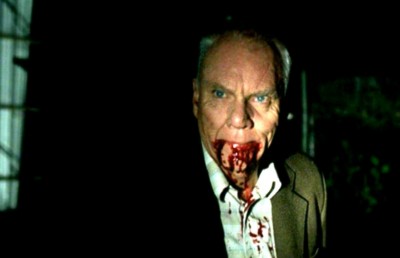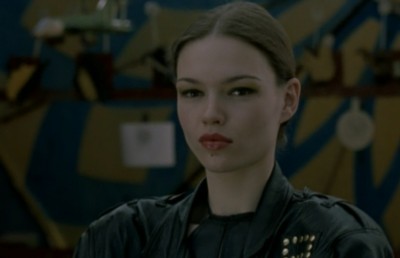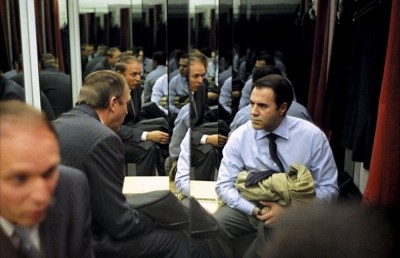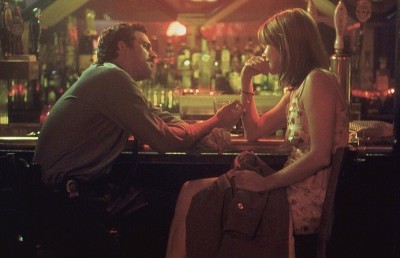Dario Argento, Maestro Auteur or Master Misogynist?
Argento and the Giallo

Is the understanding established through the psychoanalytical reading of a film text of interest/importance from a producer/director/screenwriter point-of-view?
My reaction to this question will concern the cinematic response of screenwriter/director Dario Argento to psychoanalytically charged criticism of his work. The noted Italian director has created a canon of work within the giallo form that embodies the inherently psychoanalytical symbolism found within these type of movies. It must be stated that Argento has worked outside of this form, with such titles as Un esercito di cinque uomini (Five Man Army, 1969) and Le cinque giornate (Five Days of Milan, 1973), but these films have not been considered in this treatment of him as an auteur.
The rise of feminist film theory in the 1970s and 80s coincides with Argento’s earlier film-making and could be said to have influenced the criticism of his work, in noting the reinforced sadistic-patriarchal ideology embodied within his filmic texts. Dubbed the Italian Hitchcock, Argento’s films share psychological features with the famous British director’s films, such as Psycho (1960), Rear Window (1954) and Vertigo (1957), including the accusations of misogyny and the sadistic portrayal of women that have accompanied some of Hitchcock’s works.
‘Do you know what the critics say about me? They say, “Dario, you are the most censored auteur in the history of cinema.” None of my films have escaped with less than 15 minutes of cuts. Not one.’ [1]
Reinforcing this quote, during the early 1980s Video Nasties moral panic of the United Kingdom, two of Argento’s films were named within the list of titles banned from distribution: Inferno (1980) and Tenebrae (1982). Although Argento denies being upset by his critics, actions such as cutting his work and being banned in certain countries cannot fail to leave any director unaffected.
My position here is that Argento creates statements within such films as Tenebrae and Opera (1987) that are directed at the negative accusations of sexualised violence that are said to be operating within his movies. This position can be supported by the directors own comments and through the film analysis of writers Xavier Mendik, Ed Gonzalez and Don Anderson.
Psychoanalysis and Film Theory
The emergence of psychoanalytic approaches to film can be traced to the film journal Screen in the 1970s [2], and initiated a two-prong discussion of cinema, namely the exploration of Freudian and Lacanian mental functionings of desire and inhibition as manifested within formal and narrative devices, and the formulation of an account of the act of cinema-going and spectatorship through the ‘metapsychology’ of the cinematic ‘apparatus’.
The these two elements created theoretical models of cinematic discourse and its ideological implications that were adopted by feminist film theory. These took the form of a “polemic against the structures of patriarchy which found a critical incentive in analysing the way in which the image of woman is both celebrated and degraded in cinema for the benefit of a prurient and notionally male spectator.” [3] Laura Mulvey’s landmark essay “Visual Pleasure and Narrative Cinema” (1975) politicised psychoanalysis by identifying Hollywood film as an encapsulation of male gender hierarchy. Mulvey’s analysis of classical Hollywood involved the application of Lacan’s ‘mirror phase’ and ‘symbolic order’ within Freud’s castration anxiety. Via these theories it is argued that the camera acts as the spectator’s vision into the film world which is symbolically attributed to the [male] protagonist within the narrative. A complex relationship is thus formed with the spectator actively engaging, ideologically, their onscreen ego or superego counterpart, generating pleasure through this act shared by the ‘look’ (Freud’s scopophilia) within the film’s language (which includes point of view shots, shot counter shots, etc.).
Hence Mulvey’s main argument is that spectatorship in cinema is organized along gender lines: male/active, female/passive and the visual pleasure which reflects the patriarchal ideology posits the woman as the passive to-be-looked-at-object for the “idealised” masculine gaze, of which there are three: the cameraman, the characters looking at each other, and the spectator looking at the film. While the woman represents pleasure for the male, she simultaneously evokes a threat through her lack of a penis (an unconscious reminder of the primal scene, that moment where the boy first sees the woman’s genital area and ‘lack of a penis’): the castration complex. Faced with this dilemma the male unconscious has two options:
1) employ sadistic-voyeurism, which means trying to make the woman admit her guilt, getting her to re-enact the traumatic event, aggressively pursuing, investigating and dymistifying the woman (which Mulvey explains with examples from Hitchcock), or
2) fetishistic disavowal: trying to gloss over her lack of a penis by turning her into a phallic object (which Mulvey explains with examples from the works of Sternberg/Dietrich)
For Mulvey sexual difference is expressed in film by the objectification [fetishisation] of the female form and for anxiety to be portrayed by the controlling gaze of the spectator, mediated through the protagonist. The female cannot move the narrative forward from this position and any symbolism is only granted through her relationship to a male protagonist.
The act of sadistic-voyeurism by the spectator or character occurs once the controlling ‘gaze’ is not enough and punishment is metered out to the female form due to the castration anxiety she symbolizes for the male unconscious. This is expressed in Mulvey’s example of Peeping Tom (1960), where the camera is not only the aperture of the male protagonist’s gaze, but also used as the weapon of choice, penetrating the female victims with a sharpened tripod leg, the substitute penis enacting the primal scene.
Giallo and Dario Argento
The Italian film industry in the 1960s witnessed the realisation of a new type of movie, the giallo. Mario Bava’s La ragazza che sapeva troppo (The Girl Who Knew Too Much, 1963) is often cited as the first true example. Giallo translates directly as ‘yellow’ and acquires its title from the coloured covers of the detective fiction novels that predated the films. This literary origin, akin to ‘film noir’, encompasses narratives concerned with rational and logical deduction, following the likes of Sherlock Holmes’ stories and Edgar Allen Poe’s mysteries. These books were initially reprints of British texts followed by original writing from indigenous authors. Gary Needham, in his historical-theoretical introduction to giallo “Playing with Genre,” explains that it is not a conventional genre because it ‘resists generic definition.’ [4]
By its very nature the giallo challenges our assumptions about how non-Hollywood films should be classified, going beyond the sort of Anglo-American taxonomic imaginary that “fixes” genre both in film criticism and the film industry in order to designate something specific. [5]
Although he lays down defining aspects that unite a plethora of films, it is important to consider the flexibility with which this term is applied. Needham lists examples that span from gothic horror (La lama nel corpo [The Murder Clinic, Emilio Scardimaglia, 1966]) to crime melodrama (Cosi dolce, cosi perversa [So Sweet So Perverse, Umberto Lenzi, 1969]). The very nature of this diverse range within giallo allows directors to ascribe their own style and continue to play and develop their own expression within it. What holds this body of texts together is less generic and historical and more associations of ‘murder, mystery, detection, psychoanalysis, tourism, alienation and investigation.’ [6] For this essay we will focus on the elements of detection, mystery and psychoanalysis.
Detection within the giallo has been traced by Xavier Mendik in his writing on Argento’s work back to the writings of Sir Arthur Conan Doyle and his famous sleuth Sherlock Holmes. It is not just the relevance for his instinct for detection that is important to the form, but the fact that his methods of deduction were employed by Freud in his analysis. One such patient was the ‘Wolf Man,’ a case that historically maps the issue of witnessing the primal scene, parental copulation, the creation of repressed memories and the resulting acts of psychosis. Lacan is also implicated within giallo through his readings of Poe’s work, an influence on the gothic literary and cinematic tradition (especially the work of Argento).
The common element of mystery within the giallo is figured upon the punctum: “an inconsequential detail that pricks the eye, adding something that the narrative and mise-en-scene itself can neither contain nor foretell.” [7] The punctum usually consists of the main protagonist witnessing a primal scene (usually a violent murder), from which they attempt to recall some clue to the assailant’s identity. As the protagonist pursues the mystery, they continually recollect their gaze upon this act (the punctum) for further clarity and solution. Needham, calling upon the writing of Carol Clover, points out that the giallo confounds this act of misrecognition with graphic and repeated assaults to the eye throughout its discourse. ‘The giallo eye is both penetrating and penetrated.’ [8]
The punctum thus initiates the giallo’s fascination with seeing and thus the ‘gaze’; not only with detection, but also with the presentation of violence within its narrative. The killer, instigator of violence, also engages in repetitive ‘flashback’ sequences, wholly Freudian in nature, that refer back to some repression (often a primal scene) that motivates their serial acts of murder. These acts are directed with aesthetic detail and poetic nuance through the ‘gaze’ of the assailant upon their victim. This fascination with the gaze within the texts embodies examples of both varieties noted by Mulvey: (1) sadistic-voyeurism and (2) fetishistic-scopophilia; with these tendencies marked by fragmented point of view shots of female victims penetrated with phallocentric weapons: knives, spikes, scissors and broken glass.
“I like women, especially beautiful ones. If they have a good face and figure, I would much prefer to watch them being murdered than an ugly girl or man.” [9]
This quote is attributed to the director considered by many to be the main auteur of the giallo, Dario Argento. After a career as a movie critic, Argento directed L’uccello dalle piume di cristallo (The Bird With the Crystal Plumage, 1970) helping to define not only the giallo but also establishing a fascination with perception, or the ‘gaze.’
The punctum within this film is seen by the male protagonist, writer Sam Dalmas, when he is trapped between a glass vestibule, and left to view a violent struggle between a woman and a shadowy black-coated male: the primal scene Dalmas returns to again and again. Sam witnesses the bloodied woman, Monica Ranieri, struggle helplessly before him, whilst the supposed assailant makes his escape. He is then plagued with the thought that his memories hold a clue to the identity of the attacker, and culprit of further murders. These subsequent murders are played out with great emphasis and focus, including the black-gloved murderer suggestively playing with a constraint female victim by running a knife across her body. The violent acts are constructed through fragmented shots of the attacker and weapon, the screaming victims face, and either the act of penetration by the weapon, or the bloody aftermath.
In the end the revelation is that the punctum Sam witnessed was in fact Monica attacking the shadowy male, not the other way around, as he first perceived it; Monica’s vicious rage is a response to her own repression and subsequent association with the attacker, rather than the victim within her own memories. The female sadist is common within the giallo and displays transgression of gender; the murderer could be said to embody the castrating and pre-castrated mother figure from childhood.
Although not all the victims in this film and in his subsequent work are male, criticism of his movies attach importance to the representation of beautiful women, the attention given to the acts of violence, and the complexity of his point-of-view shots. Accusations of misogyny have been extended not only through his aforementioned statement, but also by the fact that the killer’s hands within his films are always Argento’s. As such he is implicitly placing himself within the film in the role of the aggressor. Undoubtedly, Argento creates a particular aesthetisation through his use of film language. For example, great importance is given to the camera’s movement and the lighting that bathes the scenes in a colourfully overt and often garish fashion, often at the cost of narrative coherence.
Kim Newman writes in Nightmare Movies that L’uccello spawned a succession of giallo films imitating Argento’s style and approach. Dario follows L’uccello with two other films that are considered to complete the animal trilogy: Il Gatto a nove code (Cat O’Nine Tails, 1971) and Quattro mosche di velluto grigio (Four Flies on Grey Velvet, 1971). In 1975 he returns with the tour de force, Profondo Rosso (Deep Red), only to engage in a developing taste for the supernatural that is explored in the nightmarish Suspiria (1977) and Inferno. International recognition follows the success of Suspiria in the US, which coincides with Laura Mulvey’s writing of “Visual Pleasure and Narrative Cinema.”
Two of his next three films hold utmost importance to this essay, Tenebrae and Opera (1990). We shall disregard the middle film Phenomena (1985), of which Kim Newman writes, “his first film in English is an almost total failure.” [10] The specific motivation for the concentration on these two films is revealed in the following quote from Dario Argento.
“In Tenebrae there are some answers to those who have been critical of my work. The same applies to Opera where a newspaper critic is telling the director to ‘return to his old horror pictures.’” [11]
Tenebrae
The impulse had become irresistible. There was only one answer to the fury that tortured him. And so he committed his first act of murder. He had broken the most deep-rooted taboo and found not guilt or fear, but freedom. Every humiliation which stood in his way could be swept aside by this simple act of annihilation: Murder. [12]
This passage is quoted and narrated from the onscreen novel sharing the same title as the film, Tenebrae. Ed Gonzalez suggests that this is a direct disclaimer from Argento about his film-making. The self-reflexivity of the text within the text could be described as a direct reference to the criticism he has faced up to this point, and this is further emphasised by the manner in which Argento positions himself within the film.
The film’s narrative focuses on the copycat killings patterned after the central protagonist Peter Neal’s (Anthony Franciosa) writing. Neal is the author of the book within the film, “Tenebrae,” and thus can be seen as the onscreen counterpart to Argento. This positioning within the text is pushed even further when the film’s initial murder is superseded by the author himself through the clever use of an ambiguously attributed repressed memory flashback that is associated with a killer. As mentioned before, Argento is known to play the killer’s hand in all his films and here his counterpart takes on the killer’s mantle when his own thirst becomes enflamed. This plot twist confounds Neal’s response to onscreen critic Tilda, who accuses his novel of being misogynist, when he retorts that the onus is placed upon his readers. This could be read as a rather darkly humorous comment on Argento’s behalf which implies that for him to create this material there must be some aspect of the murderer embodied within him.
Mendik notes that “Tenebrae??’s production was based on the director’s deeply personal experiences. Specifically, the screenplay was moulded from real-life threats that were made to his life by an obsessed fan during his 1980 visit to the United States to promote ??Inferno.” [13] This threatening situation represents a clear reaction to his work and counters the accusations of incitement of violence to women. The first killer in the film contacts Neal by phone to express his gratification in copying the murders within his novel that provide the method to his bloody moral crusade.
The murder of Tilda, the film’s onscreen critic, and her lesbian lover Maria, provide the most extravagant use of camera movement in Argento’s work up to this point. Mendik compares the scene’s iconography to heterosexual soft-core pornography; Maria’s wet ringlet hair, her female body barely covered by a towel, “which is then discarded to reveal the ample female form behind it.” [14] What follows is an audacious two-and-half minute camera movement, achieved using a French-made extending camera dolly, that dollies out of one apartment window, cranes over the roof and rests upon the killer attempting to gain entry with a pair of bolt cutters. This over the top direction is coupled with a thunderous Goblin rock score that pushes the aesthetics of the scene. If Dario Argento is to be accused of glamorising violence then, as his disclaimer states, he finds no guilt or fear but freedom of expression. When Maria is finally dispatched, her death results in one of the most iconic frames of any Argento film: her face caught in a horrific wide-eyed stare of fascination, framed through the slash in her upheld white t-shirt, as her throat is slashed. This is one of the clearest images of sadistic-voyeurism encapsulating not only the objectification of the female form but highlighting the spectator’s gaze of the victim’s face.
The other murders of women continue to push the boundaries of explicit violence. In one case a girl attempts a desperate on-foot escape from an unending pursuit of an attack dog that culminates in her being drawn into the first killer’s lair. The last murder before Neal is vanquished portrays, in nauseating detail and vivid colour, the amputation by axe of a Neal’s wife. The blood spurting from her amputated arm onto the wall is contrasted by the unusually pale interior colors favoured by this film, which marks a stark contrast in comparison to his other works.
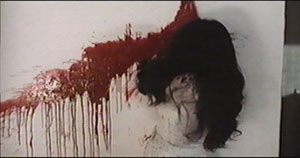
Argento’s direct and brutal response to allegations of misogyny resulted in the film being challenged critically, and suffered the continued censorship which was the fate of his previous films. If it was his intention to blast his way through the negativity, the aftermath painted a picture of failure.
Opera
Although initial readings of this film portray a continuation of the same use of the gaze and thus spectator engagement with the violence in his films, recent counter readings point to a more subtle treatment of the themes, with perhaps a response to the criticism constructed within the text. The film’s narrative tells the story of opera singer Betty and the demented killer that stalks her during her appearance in a staging of Macbeth. Unlike his supernatural films, Suspiria and Inferno, her we have a symbolic female protagonist in a true giallo.
Flashbacks are again employed to express the repressed primal scene, although these too have a somewhat ambiguous attribution. It transpires that the images of women being tortured by a male killer are in fact Betty’s own memories, which also double as the punctum. We learn that the killer was present during them and that he was indoctrinated into torturous murder by Betty’s mother. This presents a rather intriguing position for Betty, as she was witness to these acts in her childhood and through a rather disturbing iconic method is forced by the killer to be that witness again.
“Dario Argento once entertained the notion of providing audiences for his films with a row of straight pins attached to pieces of tape, which they would place directly below their eyes. This would force the spectator’s eyes to remain open during the goriest portions of his films.” [15]

This method of forced gaze is instead employed upon Betty by the killer, Alan Santini. Ed Guin writes that when Betty is bound and subjected to look, she is objectified by the spectator, which reinforces Mulvey’s view of the use of the gaze as male. This reading is countered by Don Anderson as he approaches the emphasis on the eye, common in the giallo, with philosopher Georges Bataille and the oscillation between various points of view within the scene.
Betty is the protagonist within Opera and thus the spectator’s onscreen counterpart, and Anderson suggests that unlike Mulvey and Guin’s referring to this as a case of objectification, Betty is instead increasing the number of looks from killer, victim and audience to include an additional ambivalent gaze, one that is non-gendered and all encompassing. “It is this association of the eye with genitalia (Bataille) that informs the eye with a fluid sexuality making scenes of Betty’s not only sexual but detached from normative sex binaries.” [16]
Anderson uses Bataille’s symbolic order as a substitute to Freudian phallocentrism and produces a reading that refuses objectification, by introducing Betty’s active gaze. Her armchair sadism disrupts conventional reading; the spectator is caught in a flux of looks that interact, as Anderson writes, “by way of a rhizome” (rhizome being a completely open system of meanings, in this case relating to the gaze). [17] This model postulates that there are only lines between the gazes and no final points or end from which to read a dominant position.
We can see this model as Argento’s challenge to his critics’ accusations by removing the sexual binaries within their argument, and positing a much more complex dynamic in the acting of looking upon the primal scene.
Conclusion
Dario Argento responds to the psychoanalytically charged criticism of his symbolic work with comments encoded within two of his films. The first goes for a direct attack on the negative feedback to his sexualisation of violence against women, by exploiting his real-life experiences of threats made to his life as a more obvious response to his films (or this one in particular), than the incitement of violence against women. Tenebre refuses to retreat from the criticism and instead advances the psychoanalytical symbolism to a higher level of aesthicisation. With this reflexive giallo, Argento states that he is well aware of his role and responsibility in the authorship of such a creation, and disavows the emotional paradox that he should feel for this. The result is further condemnation and accusations with continued censorship of his film.
Opera on the other hand takes a different route by evolving the psychoanalytical symbolism employed within the giallo. Instead, acute attention is drawn to the eye in a similar fashion to Luis Bunuel’s sixteen-minute surrealist short, Un Chien Andalou (1929). Its nature as an organ of pleasure accuses the protagonist Betty of involvement with the acts that unfold before her. The killer is later identified by a flock of crows that swoop down from the rafters of the opera house and graphically peck out one of his eyes. Hence a psychoanalytical reading of film —which will not bear fruit in all films— is of interest and importance to the works of Dario Argento when applied in relation to feminist film theory and its criticism of his work.
Endnotes
1 Drax S. “Filmmakers in Focus! Mondo Argento”
2 Cook P., p341
3 Ibid p342
4 Needham, G. “Playing with genre.”
5 Ibid
6 Ibid
7 Needham G., “From punctum to Pentazet, and everything in between.”
8 Needham G., “Playing with genre.”
9 Newman K., p105
10 Newman K., p109
11 Balun C., p15
12 Argento D., Tenebrae (Italy 1982)
13 Mendik X., p4
14 Ibid p23
15 Gonzalez E.
16 Anderson D., “Georges Bataille: The Globular & Cross Gender Identification Through Eyeball Mutilation In The Horror Film.”
17 Quoted in D. Anderson, “There are no points or positions in a rhizome… There are only lines. These lines always tie back to one another. That is why one can never posit a dualism or a dichotomy, even in the rudimentary form of the good and the bad” (Deleuze & Guattari, 8-9).
Bibliography
Balun, C. (1991). Deep Red special edition. New York: FantaCo Enterprises Inc.
Black, A. (1996). Necronomicon, (book one). London: Creation Books.
Braudy, L., Cohen, M. (1999). Film Theory and Criticism, Introductory readings (5th Edition). Oxford: Oxford University Press.
Cook, P., Bernink, M. (1999). The Cinema Book (2nd Edition). London: British Film Institute.
French, T. (1987). Deep Red (No. 1) New York: FantaCo Enterprises Inc.
Gelder, K. (2000). The Horror Reader. London: Routledge.
Grant, B.K. (1984). Planks of Reason. Kent: Scarecrow Press Inc
Mendick, X. (2000). Tenebrae. Wiltshire: Flick Books.
Newman, K. (1988). Nightmare Movies: a critical history of the horror movie from 1968. London: Bloomsbury Publishing Ltd.
Electronic Media
Anderson, D. (2001). “Georges Bataille: The Globular and Cross Gender Identification Through Eyeball Mutillation in the Horror Film.” rhizomes. 07 fall 2003.
Author unknown. (1990) “Dario Argento: Out of the Darkness.” Varied Celluloid.
Drax, S. (1999) “Filmmakers in Focus! Mondo Argento.” Videoscope.
Gonzalez, E. (2001) “Dario Argento’s Dreams.” Slant Magazine.
Needham, G. “From Punctum to Pentazet, and everything in between.” Kinoeye. Vol. 2, Issue 11, June 2002, and “Playing with Genre, an introduction to the Itallian Giallo,” Kinoeye. Vol. 2, Issue 11, June 2002.
Humphries, R. “Trains of Thought, Dario Argento’s Non ho sonno (Sleepless, 2000).” Kinoeye. Vol. 2, Issue 12, June 2002.


